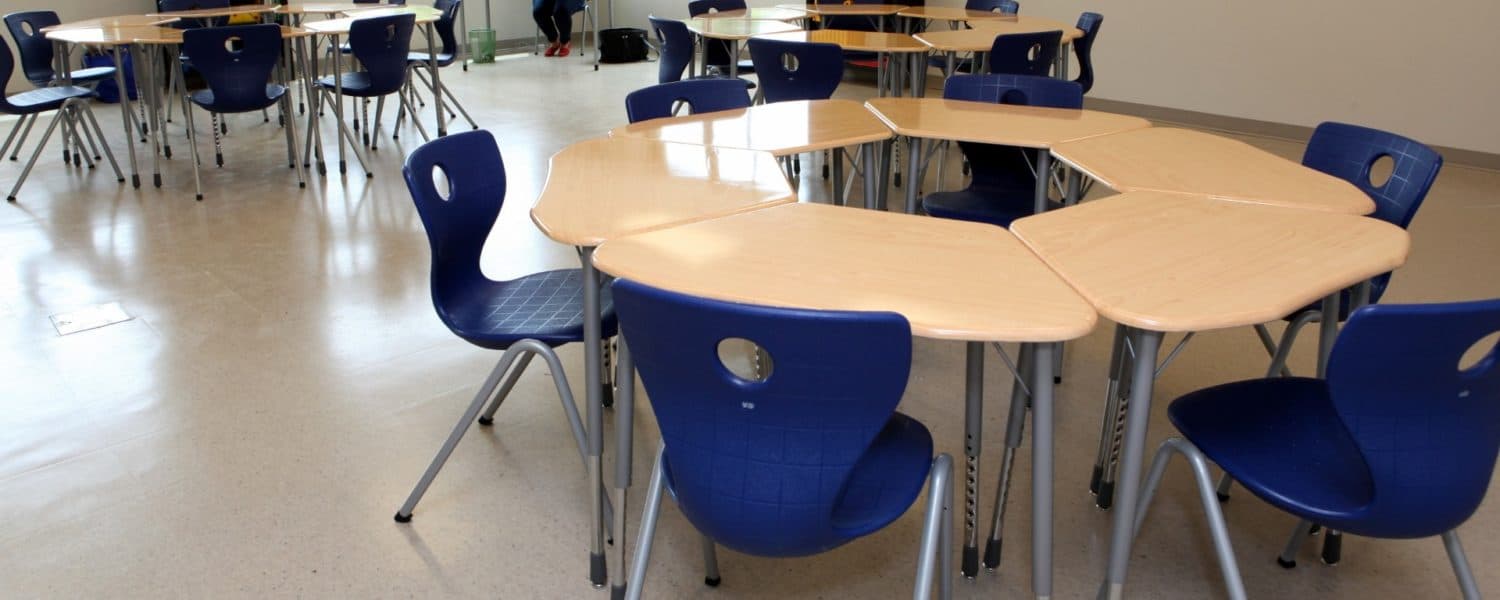When you think about the ingredients for academic success, some of the obvious ones likely spring to mind, like curriculum, teaching style, and individual discipline. While these all play a role, the physical setup of the classroom can be just as important.
According to a report from Partnership for the 21 Century Learning (P21), the cookie-cutter approach from decades past doesn’t lend itself to different types of learning styles, putting many students at an academic disadvantage.
If a student learns best while participating in hands-on activities with small groups, for example, being stuck at a desk listening to a lecture won’t bring out his or her best performance. P21 asserts, “Perhaps the most fundamental guideline is design for flexibility.”
Since no one can predict how educational technologies and teaching modalities will evolve, learning spaces must adapt to whatever changes the future may hold.”
So, what specific design elements should you consider when planning for classroom evolution?
A study conducted by the University of Salford School of the Built Environment—which found that up to 25% of a student’s progress is influenced by the classroom design—the most important design components included:
- Color
- Choice
- Complexity
- Flexibility
- Connection
- Light
Designing for Flexibility
In today’s fluid, high-tech educational system, the only true constant is change. With new technologies and teaching approaches emerging by the day, it’s important to design with flexibility in mind. Some classes may lend themselves to an unstructured format, while others are geared to more controlled environments.
One thing is for certain, the days of rows of rigid desks bolted to the floor are long gone. Today’s students need the ability to form and re-form into different groups, collaborate with peers and teachers, and move quickly from one activity to the next.
Below are just some of the modern solutions that can foster both independent and collaborative learning:
- Portable desks and chairs with rolling casters make it easy to move classroom furniture around the room without dangers or disruptions.
- Desks that can be combined together make it easy to create new configurations to accommodate changing activities.
- Kids with special sensory needs may learn better in chairs that tilt in different directions.
- Multi-function tables are designed to facilitate both collaboration and independent learning.
- Swiveling chairs make it easy for students to refocus their attention.
- Room dividers can be moved into different configurations to accommodate various groups and activities.
The physical role of teachers has also changed significantly. Instead of spending entire classes lecturing from the front of the room, today’s teachers are on the move as they interact with different groups of students. An alternative desk placement may be more conducive to modern teaching styles.
Consider Comfort
Think about your optimal working environment. Whether it’s a favorite recliner in your living room, a cozy couch at a coffee shop, or an ergonomic office chair, it offers the comfort you need to be productive.
Students also respond best to comfortable environments. In light of this, many schools now offer various types of seating, such as beanbags, rockers, oversized floor cushions or special chairs that allow students to gently tilt or bounce as they learn.
Size matters, too. With the wide variation of heights and body types among children and teens, one size most certainly does not fit all. Height-adjustable chairs and desks enable students to create a custom configuration that fits them perfectly, preventing distractions.
Optimize Color and Light
Many students are visual learners, encouraged (or stifled) by the appearance of their surroundings. Color is a key factor in influencing students’ moods, feelings, communication styles and productivity.
A study from educators at Texas Tech University explores the importance of color in creating productive learning environments.
Researchers presented six recommendations for incorporating color in the classroom:
- Shades of cream and beige work well as a warm, neutral foundation for walls, floors and ceilings.
- Soft accent colors, such as blue or green, can be implemented in certain areas throughout the room.
- Primary colors should be used sparingly, but are effective as boundaries or indicators to locate items.
- Bright primary colors should be avoided, as these can distract from learning.
While fresh paint is the most effective way to make significant color changes, classroom designers can incorporate different hues through posters, rugs, storage bins and other items.
Lighting is another important element of classroom design. Although most traditional classrooms use fluorescent light, there are many studies that show the benefits of using full-spectrum bulbs that mimic sunlight. Windows should also be leveraged to provide natural light and visual interest.
Invest in the Right Equipment
Just as important as choosing the right classroom furniture, colors, and lighting is providing access to the right learning tools. The ideal classroom should have plenty of writing surfaces to help students visualize concepts. Whiteboards can double as dividers to create private work and study areas.
In our high-tech age, access to technology is no longer a luxury: it’s a necessity for productive learning. The modern classroom should provide the tools students need to access data online, including laptops or tablets, convenient charging stations and wireless Internet access.
This information is courtesy of Connecting Elements, www.connectingelements.com.













